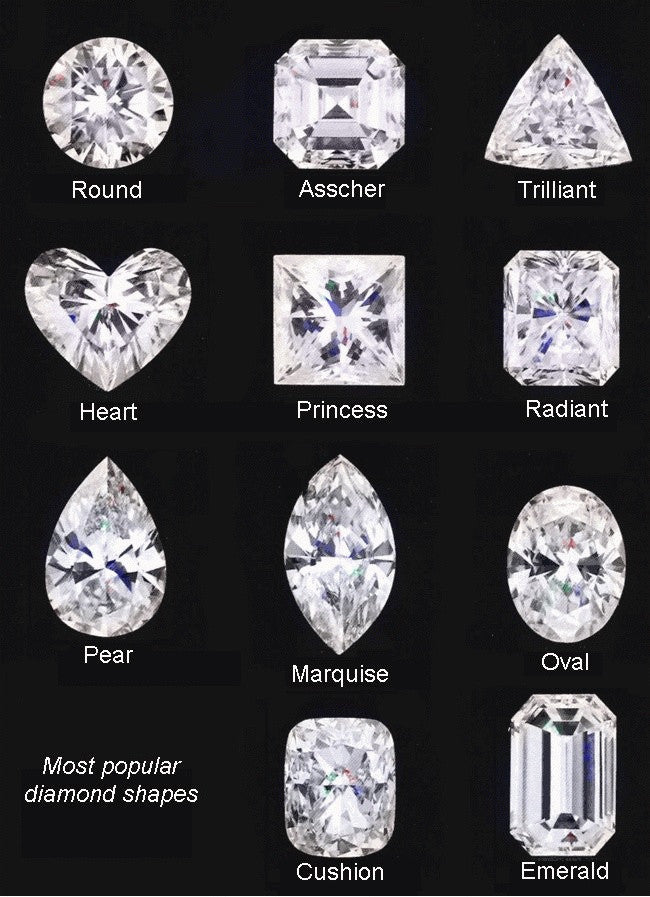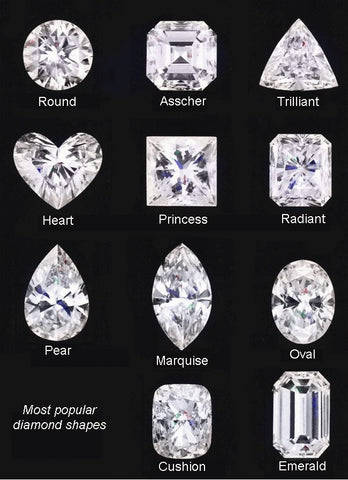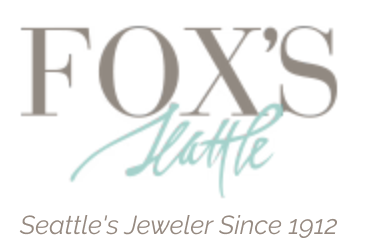Understanding Diamond Shapes

Are you just starting to look for a diamond engagement ring? One of the most important steps is to choose what diamond shape to buy! There are so many wonderful choices, all with a different look.

Round brilliant: The round brilliant diamond was devised by Marcel Tolkowsky in 1919 as his doctoral thesis at the University of London. He created a mathematical formula based on 58 facets to get the most sparkle and brilliance from a round diamond. Diamonds cut according to this formula are called ideal cut. A round brilliant diamond not cut to ideal specifications will be less expensive than an ideal cut diamond, but will not sparkle nearly as much.
Emerald: The emerald cut has been around since the 1500's, but gained popularity in the 1920's, when their sleek and elegant lines were the perfect look to go with the Art Deco movement. The emerald cut is a step cut diamond, meaning that the facets of the diamond look like stairs. The emerald cut diamond typically has 57 facets. Because the emerald cut diamond has such a large table, it isn't good at hiding inclusions. Be sure to choose a clarity grade of VS2 or better.
Oval: Diamonds have been cut into oval shapes for hundreds of years, but the modern day oval cut diamond was devised by Lazare Kaplan in 1957. Oval diamonds have 58 facets and will typically look larger than a round diamond of the same carat weight. When shopping for an oval, be aware of proportion (the ideal length to width ratio is 1.35 to 1.50), and beware the bow-tie. Oval diamonds almost always have a bow-tie effect in the center of the diamond, but results will vary - so this is an important cut to shop for in person.
Asscher: The Asscher cut diamond was designed by Joseph Asscher in 1902, and was one of the first patented diamond cuts in the world. The Asscher is step cut like an emerald cut, but the shape is square with cut corners. Like the emerald cut, the Asscher was popular in the 1920's, making it feel both vintage and elegant. The original Asscher cut diamond had 58 facets. In 1999, the Asscher cut was reinvented as the Royal Asscher by Edward and Joop Asscher. This cut has 74 facets and can only be purchased by an authorized jewelry store from the Royal Asscher Company.
Cushion: Cushion cut diamonds have soft, rounded corners, giving them a wonderful pillowy shape. Other than that, nearly every cushion cut diamond you see will be different. Some will be more square, and others more elongated. The faceting structure will be different as well. Some cushion cut diamonds have lots of small facets, giving it a shimmery crushed glass look. Others will have larger facets, giving the diamond larger flashes of light. Whichever look you prefer, you'll want to choose one of these unique diamonds in person.
Radiant: Radiant cut diamonds are available both square and rectangular, but unlike the emerald and Asscher cuts, radiant cut diamonds have the faceting pattern of a round brilliant. The radiant is a popular choice for fancy colored diamonds such as yellow, because the cut brings out the color of the diamonds. When buying an elongated radiant cut, watch out for the bow-tie effect. The ratio can have quite an effect on the look of a radiant, so this is another diamond you'll want to shop for in person.
Marquise: The marquise cut diamond dates back to the 1700's, when King Louis XV of France commissioned a jeweler to design a diamond that resembled the lips of his mistress, Jean Antoinette Poisson, the Marchioness Madame de Pompadour. Current day marquise diamonds have 56 facets and an elliptical shape with pointed ends. Marquise diamonds are traditionally set facing north-south, but famous marquise diamond wearer Catherine Zeta-Jones has her diamond set east-west.
Princess: This cut was developed in 1961, and quickly became one of the most popular diamond cuts. It is a square diamond with pointed corners and a brilliant faceting structure. Princess cut diamonds have 58 facets, but use up to 80% of the rough diamond they are cut from. In contrast, round brilliant diamonds only use about 40-50% of the rough diamond. For this reason, princess cut diamonds are less expensive than round diamonds. But watch out for those pointed corners! They are fragile and can be easily broken.
Pear: The pear-shaped diamond can be traced back to 1458, when it was created by Flemish polisher Lodewyk van Berquem. This diamond is shaped like a teardrop, with one rounded side and one pointed side, and has a brilliant faceting structure. The most famous pear-shaped diamond in the world is the 69.42ct Taylor-Burton diamond, purchased by Richard Burton for Elizabeth Taylor for a whopping $1.1 million in 1969.
Heart: The origin of the heart-shaped diamond is unknown, but the earliest mention of one is letters from 1463. Mary, Queen of Scots sent a heart-shaped diamond ring to Queen Elizabeth in 1562, as this diamond shape used to be a symbol of royalty. The heart shape is essentially a pear-shaped diamond with a cleft at the top of the rounded side, creating two shoulders. This is one of the most expensive diamond cuts, as it is labor intensive to cut, and difficult to create a perfectly symmetrical shape.
Whatever diamond cut you're looking for, come in or give us a call at 206-623-2528 and we will find exactly what you're looking for! If you know what shape of diamond you'd like to buy, but are unsure of the setting, let us set it into a beautiful diamond solitaire ring for you. The diamond can then be reset later into a setting of your choice.
